High clay contents, dense soils, and spatial variability are the principal subsoil constraints to cropping the higher rainfall land in south-eastern Australia
R. J. MacEwan A F , D. M. Crawford B , P. J. Newton C D and T. S. Clune C EA Department of Primary Industries, PO Box 3100, Bendigo Delivery Centre, Vic. 3554, Australia.
B Department of Primary Industries, 621 Sneydes Rd, Werribee, Vic. 3030, Australia.
C Department of Primary Industries, RMB 1145, Chiltern Valley Rd, Rutherglen, Vic. 3685, Australia.
D Current address: PO Box 572, Wodonga, Vic. 3689, Australia.
E North East Water, PO Box 863, Wodonga, Vic. 3689, Australia.
F Corresponding author. Email: richard.macewan@dpi.vic.gov.au
Australian Journal of Soil Research 48(2) 150-166 https://doi.org/10.1071/SR09076
Submitted: 26 April 2009 Accepted: 2 February 2010 Published: 31 March 2010
Abstract
Available soil information and unpublished data from soil survey indicate that high clay contents and high bulk density are the major subsoil constraints to crop growth in the high rainfall zone (HRZ) of south-eastern Australia. Seven high rainfall agroecological zones are proposed as sub-divisions of the region to focus future research and development. The HRZ is dominated by texture-contrast soils (69.9%) and soils with clay subsoil (89.4%) and high bulk density (mean 1.6 t/m3). Sodicity and acidity are also significant constraints to crop production in the HRZ. The physical limitations to root growth in the HRZ subsoils are best appreciated through the least-limiting water range concept and growth-limiting bulk densities. Management options and results of past research and intervention in soil loosening, drainage, raised beds, liming, and gypsum are reviewed. Climatic uncertainty raises questions about the future relevance of waterlogging as a constraint in the HRZ and confounds the development of reliable recommendations for engineering intervention.
Additional keywords: agroecological zones, bulk density, acidity, compaction, salinity, sodicity, waterlogging, texture contrast soils.
Introduction
The Grains Research Development Corporation (GRDC) commissioned a review of subsoil constraints in the high rainfall zone (HRZ) of south-eastern Australia, as part of a national research program into subsoil constraints. This paper is a summary of the principal findings reported to the GRDC (Crawford et al. 2006; MacEwan et al. 2006). We describe subsoil constraints and implications for management in the HRZ (500–900 mm mean annual rainfall) of south-eastern Australia in an area bounded by the GRDC’s southern zone. We have reviewed literature and the results of previous research into subsoil constraints in the HRZ, analysed regional geographic data, and conducted site investigations. In this paper we also present some unpublished data from earlier investigations that illustrate subsoil variability at a range of scales for a portion of the HRZ, and discuss the implications for management of subsoil constraints.
The dominant land-use in the HRZ is pasture but in the last decade there has been an expansion of cropping due to both economic and climate drivers (drier winters). Potential for crop production in the HRZ is high. Zhang et al. (2006) reviewed the potential for annual cropping in the HRZ of southern Australia, concluding that current crop yields are only 50% of potential and that the major constraints are waterlogging, lack of adapted cultivars, limited root penetration due to poor soil structure and acidity, and poor nutrient supply.
Known subsoil constraints in the HRZ include waterlogging, subsoil acidity, soil compaction, and sodicity. There is a large body of literature on each of these as well as their management. In the last decade, management techniques to overcome winter waterlogging in the HRZ by improving surface drainage and soil structure with raised beds have enabled cropping to succeed where it would not previously have been possible (Bakker et al. 2005). Substantial research has been published on compacted subsoils and their management overseas (Spoor and Godwin 1978; Soane and Van Ouwerkerk 1994; Van Ouwerkerk and Soane 1994) and, more recently, in Australia (e.g. Hamza and Anderson 2002). Subsoil acidity is a worldwide problem and Sumner (1995) has documented the causes, extent, and management. Subsoil acidity has been recognised as a significant problem in Australia where it is found in higher rainfall environments (Dolling et al. 2001). Sodic soils and subsoil sodicity are also potential constraints to agricultural production in a range of Australian environments (Naidu et al. 1995).
Reviews of subsoil constraints have been published for other Australian cropping areas. Dang et al. (2006) reviewed subsoil constraints to cropping on Vertosols and Sodosols in the subtropical, semi-arid region of north-eastern Australia. They identified several major factors that limit rooting depth and access to water in these soils, including soil compaction, dense soils, sodicity, salinity, acidity, and alkalinity. Nutrient deficiencies in the subsoil, high levels of available aluminium in acid and in alkaline subsoils, chloride (Cl–) in saline soils, carbonate (CO32–) and bicarbonate (HCO3–) ions associated with sodium in alkaline soils, and boron (B–) were also considered as potential subsoil constraints. However, the principal constraints were seen to be due to sodicity and salinity. Adcock et al. (2007) reviewed subsoil constraints in the semi-arid (350–500 mm mean av. rainfall) cropping areas of south-eastern Australia and identified sodic subsoils and saline subsoils as important features of the region’s alkaline and neutral soils. However, they observed that many factors interact and combine to cause constraints to root growth, primarily through restricting access to subsoil moisture.
Defining the high rainfall zone
The extent of the HRZ has been referred to in a general way elsewhere. For Western Australia, Poole et al. (2002) refer to 400–700 mm annual rainfall areas, while Zhang et al. (2006) recognise 450–800 mm annual rainfall as the HRZ with rainfall exceeding one-third of evaporation for 7 months of the year. An earlier definition of the HRZ used by the GRDC follows that of Prescott and Thomas (1949), who defined the lower climatic limit of the high rainfall cropping areas as ‘the areas where rainfall exceeds one third of evaporation for 9 months of the year or more’. In our analysis, we have adopted the 500 and 900 mm annual rainfall isohyets as the lower and upper limits for the HRZ in south-eastern Australia. In 1998 the GRDC delineated agro-ecological zones (AEZs) for Australian cropping areas and these are used for reporting crop statistics and strategic investment planning (Bureau of Rural Sciences 2005). Four of these zones overlap the HRZ: the NSW–Vic. slopes, SA–Vic. Bordertown–Wimmera, Vic. high rainfall, and Tas. grain areas. The relationship of these 4 AEZs to the 500 mm rainfall isohyet and the area delineated by the definition of the HRZ, as R > E/3 for >9 months, is illustrated in Fig. 1.

|
While the Vic. high rainfall and the Tas. grain areas AEZs are largely above the 500 mm HRZ lower limit for rainfall, the NSW–Vic. slopes and SA–Vic. Bordertown–Wimmera are split substantially into 2 areas and therefore contain a large portion of the land that would be considered as high rainfall under our definition (Table 1).

|
High rainfall agro-ecological zones
Agro-ecological zoning involves the inventory, characterisation and classification of the land resources which are meaningful for assessments of the potential of agricultural production systems (FAO 1981, 1983, 1996). The GRDC AEZ boundaries are based on statistical local areas (SLAs), the reporting areas used by the Australian Bureau of Statistics (ABS) for census data including agricultural statistics. The SLA boundaries have a poor relationship to landscape, soils, and climate. The GRDC AEZs therefore require revision if they are to be relevant to the HRZ. We propose 7 divisions of the HRZ to differentiate important landscape and soil differences (Fig. 2). We refer to these divisions as high rainfall agro-ecological zones (HRAEZs).
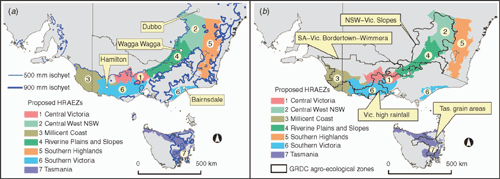
|
Soil information was accessed from State government sources in South Australia, New South Wales, Victoria, and Tasmania, and from the national data on the NLWRA website. The last was the most useful for providing a consistent level of information across the Southern Region. Regolith and bioregion maps were also consulted and used to delineate biophysical divisions of the HRZ.
The proposed HRAEZs include land not currently part of the GRDC’s AEZs (Fig. 2a) to account for expansion of cropping in south-west and south-east Victoria, and land in the eastern highlands of southern New South Wales with potential for cropping and grazing using dual-purpose wheats. The principal geographic characteristics of the HRAEZs are given in Table 2.

|
The combined total area of the HRAEZs is 21.59 Mha. If 50% of this area (10.8 Mha) is capable of producing crops with yields 50% greater than the national average of ~2.5 t/ha (3.75 t/ha), an annual production from this area of 41 Mt is theoretically possible. This amount would represent a capacity to more than double current gross national production of grains in Australia. APSIM modelling by Zhang et al. (2006) predicts yields of 3–5 t/ha for canola and 5–8 t/ha for wheat if all constraints are removed.
Soil types in the HRAEZs
Spatial analysis of soil distribution was based on the Atlas of Australian Soils (Northcote 1960, 1962, 1966). The majority of soils in the HRZ are texture-contrast soils (Isbell 2002) formerly classified as Duplex soils (Northcote 1979). In the USDA Soil Taxonomy (Soil Survey Staff 2006), these soils would correspond to Alfisols (Xeralfs and to a lesser extent Aqualfs and Ustalfs) for the higher base status soils, and Ultisols (Ustults and to a lesser extent Aquults and Xerults) for the more acidic, lower base status soils. Bleached A2 or E horizons are common and the permeability of the subsoil is imperfect or poor. A range of processes has influenced soil profile development and subsoil transformations in the HRZ. Leaching of mobile ions has led to surface soil acidification and, in the more weathered, freely draining soils, to subsoil acidification. Solution and precipitation of CaCO3 has occurred in higher pH subsoil horizons. Neo-formation of ferro-manganiferous nodules as ‘buckshot’ and weathering of ferricretes to leave residual, iron-rich gravels have resulted in gravelly phases of texture-contrast soils in many of the wetter areas of south-eastern Australia. Over millennia clay has accumulated in the subsoils as a result of weathering of primary minerals and clay illuviation. Where these clay minerals exhibit high shrink–swell behaviour, subsoils have been affected by upheaval and churning, resulting in formation of gilgai with high subsoil variability. In some landscapes, such as the Victorian Volcanic Plains, the gilgai features are not visible at the land surface due to accumulation of transported fine sand which has a levelling effect, masking the subsoil undulations (Fig. 3).
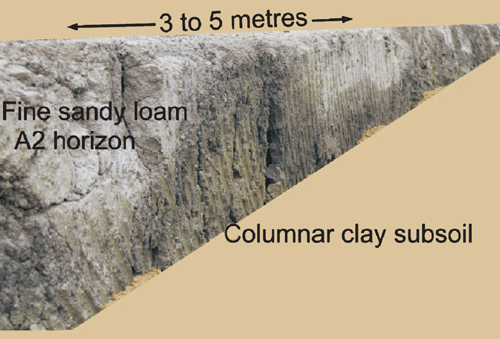
|
Accumulation or retention of sodium as an exchangeable cation has led to sodicity over large areas of the landscape and subsoils are massive or are characterised by large prismatic and columnar structural units, offering only limited opportunities for root growth.
Major soils of the south-east Australian HRAEZs
We have adopted the soil classification nomenclature from the Atlas of Australian Soils data for discussion here and for presentation of distribution of major soil across the HRAEZs shown in Table 3. This nomenclature follows, for the most part, the Factual Key of Northcote (1979). The currently accepted Australian Soil Classification (ASC) is that of Isbell (2002) but there are no direct equivalents that can be inferred, particularly for the texture-contrast or Duplex soils. In the Factual Key, divisions are based on texture profiles (e.g. Duplex) and subdivisions are based on colour. ASC soil orders (the equivalent level of divisions) are based on texture profile and chemistry, the sub-orders on colour. The criteria for colour classes in the ASC are not the same as in the Factual Key, in particular for the sub-division and sub-order terms ‘brown’ and ‘yellow’. Consequently, many soils classified as ‘Yellow Duplex’ in the Factual Key could be ‘Yellow’ or ‘Brown’ Chromosols, Sodosols, or Kurosols (the order name depending on chemistry) in the ASC. Knowledge of the distribution of sodic soils (Sodosols) and strongly acid soils (Kurosols) would add value to the assessment of spatial extent of sodicity and acidity as limitations to root growth and crop production in the HRZ but we are unable to interpret this from the readily available data. Sodosols are sodic texture-contrast soils and may occur in any of the Factual Key (Northcote 1979) Duplex soil sub-divisions. Sodicity occurs in other soil divisions, particularly the Ug (Northcote 1979) cracking clay soils or Vertosols (Isbell 2002) and some Gc (Northcote 1979) Calcarosols (Isbell 2002).

|
Texture-contrast soils dominate all of the HRAEZs. Cracking clays (Vertosols) are common in the Millicent Coast HRAEZ and occur frequently in the southern Victoria HRZ, often in complexes with Sodosols, but are rare in the other HRAEZs. Calcarosols are common in the lower rainfall cropping regions and rarely found in the HRZ. Table 3 shows the distribution of the dominant soils in each HRAEZ and across the HRZ. The Yellow Duplex (Northcote 1979) subdivision is the most common soil type in 5 of the 7 HRAEZs and comprises 42.2% of the total HRZ soils. These may be Yellow or Brown Sodosols or Chromosols in the ASC but are unlikely to be Kurosols. Red Duplex (Red Chromosols, Sodosols, and Kurosols) dominate the central west NSW and the Riverine Plains and Slopes HRAEZs. This reflects the warmer, drier climate of these HRAEZs compared to the others, the red subdivision indicating greater oxidising conditions than in the brown, yellow, black, and gley subdivisions.
On an areal basis, subsoil textures are generally indicated as clay for 89. 4% of the HRZ, clay loams and light clays for 7.8%, and sands, sandy loams, and loams for 2.8% of the HRZ (NLWRA 2005). Distribution of subsoil texture groups across the HRAEZs is shown in Table 4. In Table 5, subsoil values for pH and estimates of bulk density summarised from the NLWRA data indicate a region with dense clay subsoils and a wide range of subsoil pH (NLWRA 2005). Many soils exhibit, or are at risk from, subsoil acidification, and many others with high pH may also have associated chemical constraints.
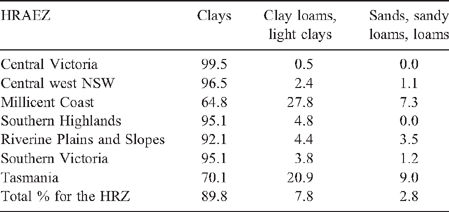
|
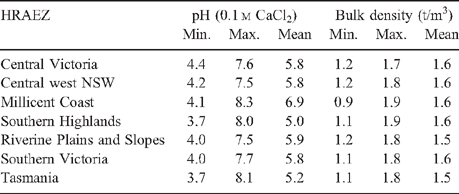
|
Subsoil variability in the HRAEZs
Subsoil variability complicates diagnosis of constraints and prescriptions for management at the regional and paddock scale. To illustrate this, we present 3 sets of data: results of paddock transects in 4 of the HRAEZs, data from a pipeline transect and cropping sites in the southern Victoria HRAEZ, and closely spaced pit data at a mole drainage trial site in the Riverine Plains and Slopes HRAEZ.
Comparison of four paddocks across the HRZ
Site locations and soil types are given in Table 6. Soil samples from the surface horizon and 3 subsoil horizons (nominally 0.20–0.30, 0.45–0.55, and 0.80–1.00 m depth) were collected for 20 or more points along a topographical transect. Samples were analysed by wet chemistry and mid infrared spectroscopy. Profile data for the 4 sites representing major soils in the HRAEZ are shown in Fig. 4; only the summary profile data for the sites are presented.

|
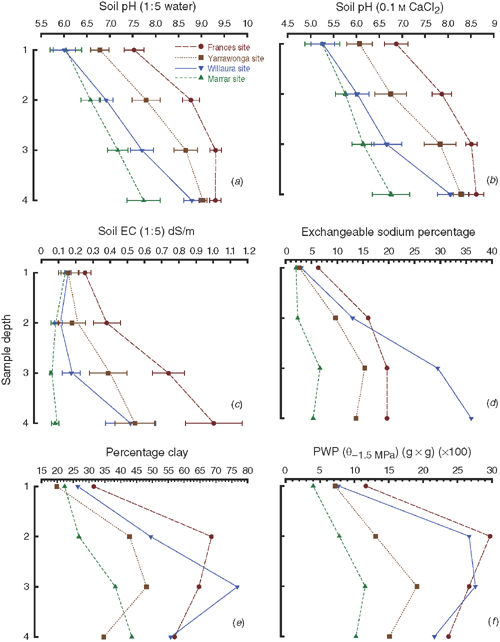
|
Spatial variability in subsoil properties was high across all of the surveyed paddocks. None of the sites presented a potential subsoil acidity problem, although the topsoils at the Willaura and Marrar sites will need to be monitored. Only the Frances site (Millicent Coast HRAEZ) Grey Vertosol exhibited higher levels of exchangeable aluminium (>10 µg/g) than the other sites.
Subsoil variability within the southern Victoria HRAEZ
Soil data from cropping sites in the Western Plains (southern Victoria HRAEZ), and a pipeline trench across the south-east of the Western Plains, indicate variability and trends in some key soil properties across the region (R. J. MacEwan, unpubl. data). Figure 5 shows data for the raised bed cropping sites. Profile data were grouped by pedology and depth. The depth intervals shown on the y-axis of Fig. 5 approximate to the 5 control sections recommended in the Australian Soil Resource Information System (ASRIS) (McKenzie et al. 2005). Trends of increasing pH, sodicity, and clay content with depth are common features in this HRAEZ. The lower values for pH and clay for depth interval 2 are associated with A2 horizons (usually bleached) that are common in the region’s texture-contrast soils. The pipeline trench data show a trend in subsoil sodicity (Fig. 6) which increases towards the east of the Western Plains. Profile descriptions revealed a similar trend for Bk horizons with soft accumulations of CaCO3. This trend could reflect a rainfall gradient across the region and higher potential for leaching in the west or a geologic trend in younger volcanic deposition, and therefore less time for regolith weathering, also towards the west.
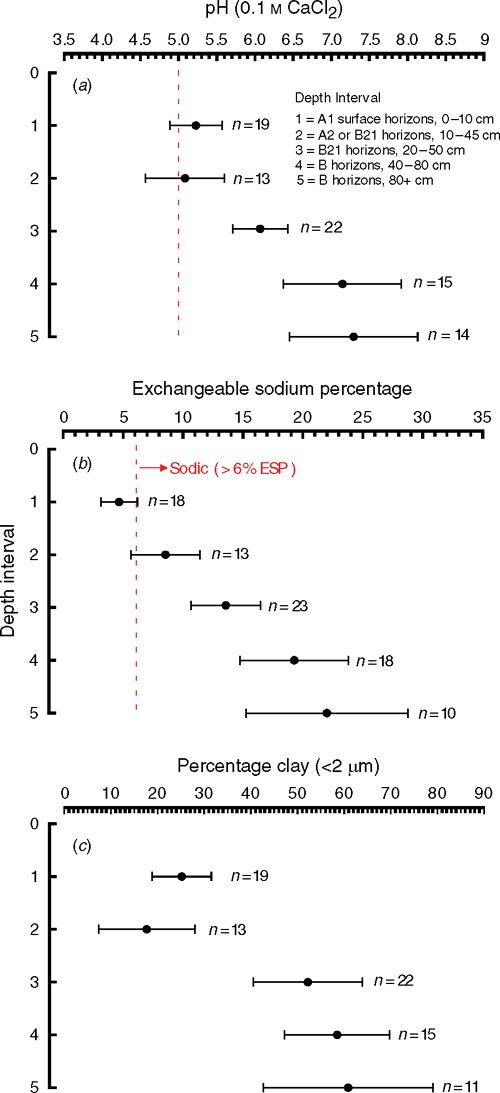
|
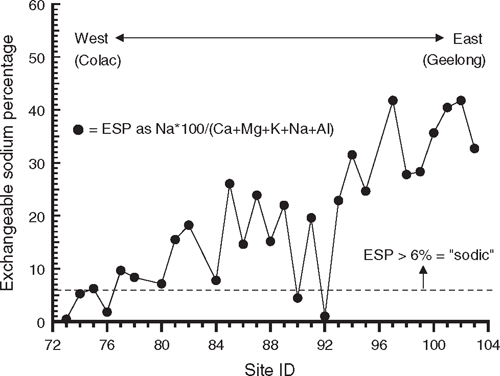
|
Clay content is an important constraint as wilting point moisture content is strongly dependent on soil texture; the relationship between measured clay percentage and wilting point is shown in Fig. 7 for soil samples collected in the Western Plains (southern Victoria HRAEZ) from the raised bed sites and pipeline trench.
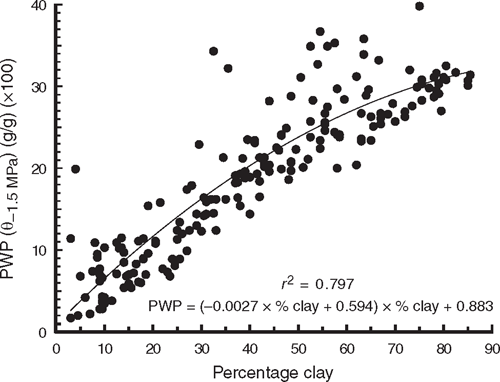
|
Subsoil variability at paddock scale
Legacy data from mole drainage research in north-east Victoria serve to illustrate high within-paddock subsoil variability. Success of mole drainage installation at Rutherglen from 1989 to 1991 was confounded by high variability in subsoil properties and mole drain stability (MacEwan et al. 1992). Successful mole drain installation depends on several factors that have been reviewed previously (Spoor et al. 1982a, 1982b, 1987). The survival and longevity of mole channels at the Rutherglen site were in doubt due to the sodic nature of the subsoil and variable thickness of ‘spewy’ bleached A2 horizons. An experiment was set up in October 1990 to investigate 4 variations in mole channel installation (R. J. MacEwan, unpubl.). Each of the 4 installation methods was replicated 12 times, moles were installed 2 m apart. In March 1991, moles were excavated to determine the effects of summer rainfall and drying on channel condition and to determine the relative effectiveness of installation methods. Each mole channel was excavated at its lowest end (interception with a pipe drain) and at a point 20 m upslope. Ninety-six soil pits were dug to a depth of 0.80 m. Mole channels were photographed and measured for several stability factors that had been published previously (Spoor and Ford 1987). Bulk soil samples were collected from moling depth (0.45–0.60 m) and analysed for chemical and physical properties. The soil samples collected from moling depth were extremely variable, to the extent that 3 different subsoil types were readily recognisable on the basis of colour, structure, and texture. Variation in some of the subsoil properties measured is shown in Fig. 8.
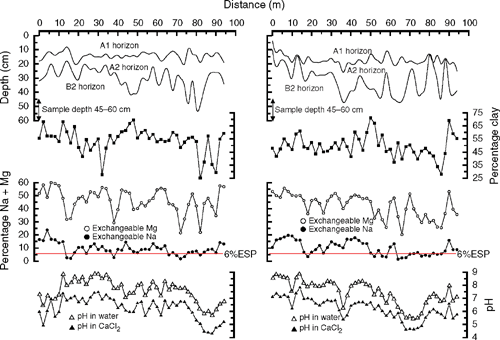
|
The variability of the pedological profile at this site is indicated by the boundary between the A2 horizon and the clay B2 horizon. Clay content, pH, sodicity, and exchangeable Mg at 0.45–0.60 m depth are also highly variable. This degree of variability confounds interpretation of crop performance in relation to subsoil constraints as these properties affect water availability, soil strength, nutrient availability, and ion toxicities. Similarly, this degree of variability can confound management aimed at amelioration of limitations.
Soils were sampled at an additional 30 points for determination of subsoil bulk density. Bulk densities (t/m3) of 1.60 ± 0.18, 1.64 ± 0.16, and 1.63 ± 0.15 (95% CL) were recorded for 0.40–0.50, 0.50–0.60, and 0.60–0.70 m depths, respectively. Texture was highly variable (41 ± 15% >0.02 mm sand fraction), ranging from sandy clay to heavy clay. Bulk density was only weakly positively correlated with sand content (r = 0.14); clay content is a better predictor of bulk density (see for example, Heuscher et al. 2005; Benites et al. 2007) but was not determined for these samples.
Discussion
Physical subsoil constraints in the south-east Australian HRZ
Physical constraints to root growth are water availability, mechanical impedance (soil strength), and soil aeration. All of these are affected by 4 soil properties: soil texture, bulk density, porosity, and soil water content. Furthermore, there are important relationships between soil texture, bulk density, and porosity that compound with water content to create constraints to root growth, these are summarised in Table 7.

|
The transmission pores provide space in the soil for mechanically unimpeded root growth. Fine roots (<0.6 mm diameter) may comprise as much as 70% of the root architecture (Zobel 2005) and will grow readily into these pores and subsequently enlarge them through radial expansion and compression of the surrounding soil. The presence, volume, and distribution of continuous transmission pores are therefore critical in determining unimpeded root growth. In subsoils of the HRAEZs, transmission pores are not common and are often widely spaced, principally occurring as fissures between large structural units.
Roots will also grow into the soil matrix if moisture is available. Compression of the soil in a pre-existing pore or penetration of the soil matrix by roots requires that the root can overcome the mechanical strength of the soil. Soil strength depends on moisture content, soil texture, and bulk density. In clay soils with high bulk density, mechanical strength can be high even when most of the pore space is filled with water.
Bulk density affects the mechanical strength of soil directly through the packing and arrangement of soil particles, and texture influences soil mechanical strength through its effect on pore size distribution. The growth-limiting bulk density (GLBD) at which root growth is mechanically impeded therefore varies with texture (Daddow and Warrington 1983; Jones 1983). Indicative GLBDs after USDA (1999) are shown in Table 8. The NLWRA data indicate that average bulk densities in the HRAEZs range from 1.1 to >1.9 t/m3 with a mean of 1.5 t/m3 (Table 5). The density of the soil matrix (i.e. excluding macropores) will exceed these values and it is likely that subsoil strength will constrain root growth, particularly in the clay soils, although roots will grow into pores and fissures.

|
Aeration depends on the volume and continuity of transmission pores. In dense or compacted soils these pores comprise a smaller fraction of the total pore volume than in less-dense soils and they are the first pores to be sacrificed when soils become compacted. Critical air-filled porosity depends on texture (Pierce et al. 1983). Gas diffusion and replacement of CO2 with O2 is more efficient in structured clay soils than in apedal sands in which macropores are restricted at the contact points between sand grains. Root growth limiting air-filled porosities proposed by Pierce et al. (1983) are given in Table 8.
Least-limiting water range and growth-limiting bulk density
The physical subsoil constraints in the HRZ are well explained by the least-limiting water range (LLWR), which serves as an index of soil structural quality integrating values of soil matrix potential, aeration, and soil strength (da Silva et al. 1994). The application of this concept has been the subject of several publications (Zou et al. 2000; Benjamin et al. 2003; Wu et al. 2003; Lapen et al. 2004; Leao et al. 2006). Groenevelt et al. (2001) went further and proposed the term ‘integrated water capacity’ (IWC) as a development from LLWR, introducing overburden pressure as another factor and integrating changes in bulk density of swelling soils to allow for better estimation of water availability.
Estimation of LLWR is not possible for HRZ soils without data on field capacity and related air-filled porosity or soil mechanical strength. However, a simple representation of the limiting air filled porosities (from Table 8) and wilting point values for different soil textures (for example from a pedotransfer function such as illustrated in Fig. 7) at a range of bulk densities can be used to indicate the threshold bulk densities at which water availability becomes excessively restricted.
Figure 9 illustrates the relationship between volume fractions for hypothetical values for air-filled porosity (after Pierce et al. 1983) and wilting point moisture contents at a range of bulk densities from 1 to 2 t/m3 for 3 texture groups. Total porosity has been plotted against bulk density (ρ), using an assumed particle density of 2.65 t/m3, where total porosity = 1 – ρ/2.65. Volume fractions for moisture content at wilting point have been plotted using gravimetric values of water content at wilting point (θ–1.5 MPa) estimated from Fig. 7, and multiplying by bulk density to calculate volumetric water content at –1.5 MPa. An approximate value for the LLWR can be estimated from the volume fraction difference between θ–1.5MPa and critical air-filled porosity for any given bulk density and texture.
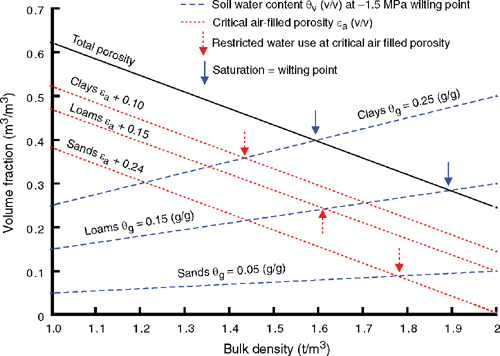
|
Intersection of the line representing θ–1.5 MPa with the corresponding critical air-filled porosity line for the same texture represents the bulk density at which soil aeration may be restrictive at wilting point (Fig. 9). Bulk density is completely growth-limiting at the value represented by the point of intersection between the θ–1.5MPa line and total porosity. Intersections between wilting point and critical aeration values in Fig. 9 indicate GLBDs for 3 texture classes, and these values compare well with those given in Table 8 after USDA (1999). The GLBDs for different textures would appear to be a useful indicator for judging physical subsoil constraints. Bulk density values for the HRZ subsoils (Table 5) are therefore interpreted as growth limiting, as the dominant soil texture is clay, the mean bulk density 1.6 t/m3 or higher, and the GLBD value for clay theoretically lies between 1.4 and 1.6 t/m3.
GLBD, LLWR, and the rhizosphere
HRZ subsoils appear to have small LLWRs. A small LLWR is highly likely to induce stresses throughout the growing season as the window of opportunity for water storage and extraction is very narrow. da Silva and Kay (1997) showed that a small LLWR soil induces more stress due to both drought and waterlogging than a soil with a larger LLWR.
While the GLBD is a useful indicator of a poorly structured soil with respect to reduced LLWR and low potential for root growth, there are other aspects of structure that should be considered. Bulk density is a simple parameter that does not reveal pore geometry. The number, volume, connectivity, and orientation of macropores are particularly important in dense soils as they determine air and water movement to a limited rhizosphere. In structured clay soils, roots are usually observed in fissures, interpedal pores, and biopores. While the volume occupied by roots in such soils may be small, the physical environment is quite different to that measured in the bulk soil.
Whalley et al. (2005) demonstrated that water retention and aeration properties of the rhizosphere soil are enhanced with respect to root growth compared to the properties of the bulk soil. Passioura (2002) describes the many interactions between root and soil that demonstrate the ability of plants to adapt to and survive in stressed situations. Gregory (2006) proposes that more integrated research into root–soil interactions in the rhizosphere is required because roots are an essential part of soil.
Chemical subsoil constraints in the south-east Australian HRZ
High rainfall zone soils research has generally focused on the impacts and alleviation of soil acidity (e.g. Helyar 1991; Scott et al. 2000) and waterlogging (e.g. Belford et al. 1990; Cox and McFarlane 1990, 1995; MacEwan et al. 1992; Sarlistyaningsih et al. 1995; Christy 1996; Malik et al. 2002; Barrett-Lennard 2003; Peries et al. 2004) on soil processes and plant growth responses.
Acidity
Soil acidity restricts plant growth through impacts on internal metabolism of the plant as a consequence of nutrient toxicities associated with Al3+, H+, and Mn2+. It also impacts on the availability of trace elements such as molybdenum. Soil acidity is limiting to the production of most crop species at pH <5.0 (Helyar 1991). Interactions between waterlogging and acidity increase the hazard posed by toxicity from Al3+ and Mn2+ in the HRZ.
Surface acidity in the A1 horizon is already a management issue for HRZ producers, particularly on texture-contrast soils (Helyar 1991; Coventry 1992; Scott et al. 2000). This has resulted from elevated rainfall, more intensive crop production strategies (e.g. increased application of N), an environment more conducive to nutrient turnover and N mineralisation, and the greater opportunity for losses of excess nutrients through leaching (Helyar 1991; Raij 1991; Coventry 1992; Scott et al. 2000). Current data (NLWRA 2005) suggest that subsoil acidity in the HRZ is generally at a level that will not inhibit the production of most crop species. However, the development of subsoil acidity is a hidden but significant threat as cropping activities expand in the HRZ and increases in nitrogen fertiliser application occur in order to meet higher yield expectations (Helyar 1991; Coventry 1992; Scott et al. 2000).
Subsoil acidity in the Southern Highlands and Tasmanian HRAEZs may require further investigation to determine whether it is actually a problem on arable land. The generalised data presented in Table 5 represent all soils mapped in the HRAEZ and will include attributes of soil in terrain unfit for cropping.
Salinity
Salinity of arable land associated with shallow saline groundwater, although highly publicised, is not a major feature of the south-east Australian HRZ except for some areas of the Millicent coast HRAEZ and lower lying land in the Victorian Volcanic Plains (southern Victorian HRAEZ). More commonly, transient salinity, associated with poor permeability of subsoils, may occur in the root-zone unrelated to any groundwater influence (Rengasamy 2002). Transient salinity is associated with reduced subsoil infiltration common in texture-contrast soils, particularly Sodosols.
Regardless of the causes of salinity, the effects are the same. The primary impact of salts in the root-zone is to reduce water availability through the osmotic effect on total water potential.
Groenevelt et al. (2004) modelled water availability in saline soils, and this exhibits a dependence on texture, particularly at the lower end of the LLWR. They modelled 3 soils with a low ECse of 2 dS/m, taking into account the osmotic potential of the soil water. Wilting point (–1.5 MPa) occurred at a matric potential of –0.95 MPa for a loamy sand, –1.18 MPa for a calcareous loam, and –1.37 MPa for a marine clay.
This theoretical approach of Groenevelt et al. (2004) would suggest that transient salinity at equivalent EC values will have greater impact on the lower limit of LLWR in coarse-textured than in fine-textured soils (Kelly and Rengasamy 2006). There is a simple explanation for this that can be derived from the moisture characteristics for different textures and the corresponding differences in gravimetric moisture content for pure water at –1.5 MPa. The values used in Fig. 9 can be used as an example: θfc (g/g) for sand is 0.05 and for clay 0.25. At θfc the sand therefore would have 5 times the concentration of salt as the clay for the same ECse. The greater dilution effect in the clay compared to the sand results in the total water potential reaching –1.5 MPa much earlier in the sand than in the clay. Transient salinity effects may therefore be greater in A2 horizons than in the clay B horizons of the HRZ texture-contrast soils, and this is a potential factor that would limit root extension through the A2 and into the B horizon.
Sodicity
Sodic soils are common throughout the HRZ. The impact of sodicity on crop production has been extensively reviewed (McKenzie et al. 2002; Rengasamy 2002; Surapaneni et al. 2002). Soil sodicity limits plant growth indirectly through poor physical conditions and directly as a consequence of sodium toxicity. The poor physical conditions result from the dispersive behaviour of sodic clays, which, through blocking of fine pores and densification of the soil matrix, reduces water availability and soil aeration. Sodicity generally increases with depth and this is illustrated well by Fig. 5 but may also vary within a region (Fig. 6) and within a single paddock (Fig. 8). These data provide some evidence of general trends in one HRAEZ but also indicate the high regional variance in a single property, such as sodicity, both vertically and laterally.
Nutrient availability
A variety of other chemical constraints impact on crop production in association with the more obvious subsoil conditions such as waterlogging and acidity. For example Al, Mn, and H toxicities, and Mo deficiencies, are associated with acidic soils (Helyar 1991). Plant-available Al and Mn increase in acid soils in the presence of waterlogging (Khabaz-Saberi et al. 2005). In alkaline subsoils, Na, B, Al, and carbonate toxicities have been identified (Rengasamy 2002). In addition to the major chemical constraints identified above, several subsoil constraints have been identified. Limited nutrient availability has also been identified as a subsoil constraint to plant growth and root exploration of the soil (Gourley and Robson 1992; Rengasamy 2002).
Management strategies for HRZ subsoil constraints
The most common soils in the HRZ are those with strong texture-contrast profiles (Sodosols, Chromosols and Kurosols). The topic of crop production on these soils was reviewed extensively at a national workshop in Perth in 1992 (CSIRO 1992) and most of the physical issues and management approaches identified then are still pertinent.
Deep and deeper tillage
Mechanical loosening of the soil profile is widely recognised as a means to address physical impediments to plant growth in cropping soils. Mechanical loosening of subsoils involves deep tillage, also known as deep ripping (Reeves and Touchton 1991; O’Sullivan 1992; Dunker et al. 1995; Allen and Musick 2001; Wesley et al. 2001) and subsoiling (Sojka et al. 1990; Jasa and Dickey 1991; Reeves and Mullins 1995; Raper 2005). Interactions between soil and tine have been researched and known for the last 30 years (Godwin and Spoor 1977; Spoor and Godwin 1978) but the field application of ripping is highly varied and often without sufficient cognisance of the processes governing success. Spoor (2006) has summarised a career of experience in the alleviation of compaction and clearly describes the principles for its diagnosis and treatment.
There is strong evidence for the benefits of deep ripping on the reduction of compaction, increase of air filled porosity, and improved hydraulic conductivity. However, the effects of deep ripping on plant yield appear to depend on several factors other than the cultivation strategy alone (Reeder et al. 1993; Hamza and Anderson 2003). Several studies have described positive impacts of deep ripping on soil character and plant growth (Table 9).

|
Drainage
The engineering design criteria for agricultural drainage systems are extremely well documented and understood and do not require major research (see, for example: IILRI 1974; Schilfgarde 1974; Smedema and Rycroft 1983; Eggelsmann 1987). The soil mechanics of mole drainage and the design of appropriate equipment for installation have been thoroughly researched overseas (Spoor et al. 1982a, 1982b; Spoor and Ford 1987; Spoor 1995) and applied in Australia (MacEwan et al. 1992; Christen 1994; Christen and Ayars 2001). The fundamental problem with mole drains, besides difficulties of achieving installation of stable channels, is their hydraulic behaviour. Moles are very effective at removing excess water from the ground surface; the network of cracks that are created between the mole plough leg slot and the ground surface rapidly conduct surface water preferentially to the mole drain which then conveys it away from the site. This bypass flow is an issue for soil water management in Australian climate and weather conditions as it is most rapid and complete when the soil is dry and cracked, i.e. in conditions when the soil matrix has the highest requirement for water in order to raise its water content into the available range.
In the context of climate variability and the intermittent nature of waterlogging, the benefits of drainage are not easy to estimate. The main research on drainage in south-eastern Australia was conducted from the early 1980s to early 1990s, which was a period of wet winters during which crop losses due to waterlogging were high. Review of yield data from drainage research in conjunction with modelling over different seasons may be worthwhile in characterising seasons in which yield would be improved through drainage. Drainage removes excess water when it needs to be removed but there are no systems in place that allow storage of the water and its re–application at a time when it may be needed to fill grain. In times of increasing water uncertainty a better tactic than drainage would be one that improves the water storage and aeration properties of the soil profile.
Raised beds
Raised beds are an alternative to open field drainage lines. The raised beds are a successful management strategy to improve and protect the upper part of the soil profile – the better quality topsoil, loosened and formed into a bed, has improved aeration conditions and is protected from surface ponding or re-compaction. Beds are being increasingly employed to manage waterlogged cropping soils across southern Australia, with >30 000 ha of broadacre raised beds in Victoria and Western Australia (Peries et al. 2004; Bakker et al. 2005). Soil variability, especially in complexes of Vertosols and Sodosols found in the Victorian Volcanic Plains, can potentially lead to inconsistent bed quality with poorer structured material such as that found in the A2 (‘spew’) horizons being brought to the surface.
While there is good evidence for potential yield improvement resulting from the adoption of raised beds, ongoing research into the agronomy associated with their use is required to ensure the potential is realised (Peries et al. 2004; Bakker et al. 2005).
Subsoil waterlogging and aeration constraints in paddocks with raised beds may be lessened due to improved water use in the upper part of the profile. This, in combination with the drainage function of the furrows or inter-bed soil, could reduce the frequency of waterlogging of the profile and encourage deeper and more prolific root growth. However, beds have been installed and studied only in the last decade during which the winters have been drier than in previous decades and waterlogging has not been such a serious regional issue.
Slotting
Slotting can be used to moderate physical and chemical constraints in the subsoil (Blackwell et al. 1991). A narrow slot 100–150 mm wide and 0.4–1.0 m deep is cut into the soil at spacings determined by the farming system; loosened soil in the slot leaves a physically improved root-zone. Soil can be mixed with ameliorants before replacement to address subsoil limitations of sodicity, acidity, and nutrient deficiency. Slotting has been applied in irrigated bed systems, under vines, and for the disposal of waste (Jayawardane et al. 1995). Soil between the slots remains undisturbed and there is a risk that the slots become waterlogged, thus undoing the benefits of a more open soil structure. To overcome this problem slots have been combined successfully with mole drains in irrigated bed trials on a Sodic Grey Vertosol at Griffith (Muirhead et al. 1996).
Chemical amelioration
Subsoil nutrient limitations have been identified as a cause of poor root and, consequently, plant development (Gourley and Robson 1992). Deep placement of fertiliser has been successful in low rainfall environments (for example at sites on the Eyre and Yorke peninsulas of South Australia). It remains to be seen whether the impacts are as great in higher rainfall environments.
Acidity
Acid surface soils can be readily modified by incorporation of lime, but amelioration of low pH in the subsoil is more challenging (Scott et al. 2000). Surface applications of lime can, with sufficient time, ameliorate acid subsoils. Scott et al. (2000) found that lime, surface applied to Australian pastures, took between 2 and 72 years to move to a depth of 0.20 m depending on geography, soil type, management, and climate. Conyers et al. (2003) found that in an Australian cropping environment, lime incorporated in conventional tillage or direct drilling failed to move beyond 0.10 m depth after 8 years. In contrast, surface application of lime to sugarcane in north Queensland increased pH to a depth of 1.00 m (Noble and Hurney 2000). The major difference between the latter 2 examples is the leaching fraction provided by annual rainfall, with the former being 570 mm and the latter 4300 mm.
There is evidence to suggest that fulvic acid derived from coal, applied to the soil surface, is effective in ameliorating subsoil acidity; however, its local application requires testing (van der Watt et al. 1991). Work by the Department of Agriculture in Victoria led by Ellington in the 1980s did not show any measurable benefits that could be attributed surface additions of powdered brown coal or subsoil injection of brown coal slurry (a source of fulvic acid).
Subsurface incorporation of ameliorants such as lime is often regarded as economically prohibitive (Scott et al. 2000). However, this perception is based on gross margin analysis of pasture industries rather than broader, whole-farm economic analysis. Management of soil acidity, especially subsoil acidity, is an area that requires research into engineering aspects as well as the chemical processes in the soil. There are significant technological hurdles to be overcome for deep placement of ameliorants and there may be some potential from the use of gypsum at high rates rather than lime.
Sodicity
Gypsum application is a common practice for the amelioration of sodic soils (Jayawardane and Chan 1994) and has generally been applied to the soil surface (Ellington et al. 1997). Incorporation of gypsum at depth (MacEwan et al. 1992) and gypsum analogues (Jagadeeswaran et al. 2002) have been used to stabilise sodic subsoils. Surface application of gypsum has also been demonstrated to increase the benefits of liming on acidity (Farina et al. 2000a, 2000b). Gypsum also has a role in dealing with transient salinity by enhancing leaching of salts from the subsoil (Kelly and Rengasamy 2006). Rates of gypsum commonly applied range from 1 to 5 Mg/ha, with the higher rates usually confined to research trials. Much higher rates may be needed to fully ameliorate the soil profile as experiments overseas have demonstrated (for example, Toma et al. 1999; Farina et al. 2000b).
Acidity and sodicity
As many of the HRZ soils are both acid and sodic these issues may need to be managed in combination. Research into the combined effects of lime and gypsum has been conducted overseas and in Australia, often in combination with tillage treatments such as ripping and slotting to overcome physical constraints and to facilitate lime distribution through the profile. Subsurface incorporation of lime and gypsum have been demonstrated to be effective for amelioration of subsoil acidity (Coventry 1991; Farina et al. 2000b). Differences in responses between soil types in the same region have been found (Ellington 1986) and so management prescriptions are not simple or predictable at present.
Biological amelioration
Biology has an important role in the amelioration of subsoil constraints. The utilisation of plants as a basis for rehabilitating compacted subsoils has been reviewed (Cresswell and Kirkegaard 1995; Yunusa and Newton 2003). While Cresswell and Kirkegaard (1995) focused on the capacity of tap-rooted perennial species such as lucerne, Yunusa and Newton (2003) concentrated on short phases of woody perennials. Both approaches sought to achieve the same result, by employing the perennial species acting as biodrills or primers, to increase air-filled porosity and water storage capacity and access to water in hostile subsoils. Although the concept is well founded in theory, both reviews conclude that the concept requires testing at the field scale. Radford and co-workers demonstrated that a 3-year pasture ley could effectively ameliorate compaction resulting from vehicle traffic (Radford et al. 2001).
There is evidence that soil macrofauna, particularly earthworms and ants, have a significant role to play in alleviating the impacts of compaction in agricultural soils (West et al. 1991; Larink et al. 2001).
Grazing management
This is significant for mixed farming enterprises where forage production (using either pasture-based systems or forage cereals) is a component of the system. Appropriate management of grazing animals on wet soils, particularly cattle (Taboada and Lavado 1993; Greenwood and McKenzie 2001; Nie et al. 2001; Taddese et al. 2002) and to a lesser extent sheep (Proffitt et al. 1993) is essential to avoid the development of subsoil compaction.
Controlled traffic
Controlled traffic farming has been utilised extensively internationally as a means of minimising compaction in intensively farmed environments (Hamza and Anderson 2005). Controlled traffic farming (Bailey 1997) minimises compaction through the use of designated vehicle pathways and is highly suited to row-cropping activities (Halderson et al. 1993; Braunack et al. 1995; McPhee et al. 1995a). It has gained momentum in Australia with the advent of precision agriculture technology and is an important component of raised beds (Peries et al. 2004).
Confining compaction to narrow bands reduces tillage draught, enabling lighter equipment to be used, further decreasing the risk of compaction and reducing fuel consumption required for tillage (McPhee et al. 1995b; Tullberg 2000). Improved infiltration and access to stored soil water also increases the timeliness of operations and enterprise flexibility (Braunack et al. 1995; McPhee et al. 1995a). The implementation of controlled traffic is an essential partner to soil loosening if ongoing compaction is to be reduced (McPhee et al. 1995a, 1995b, 1995c).
Soil type may have a significant impact on the success of controlled traffic in the HRZ. There has been research in Australia on cracking clays used for row-cropping (McPhee et al. 1995b; Tullberg 2000). However, the application of tramlines on texture-contrast soils has not been much researched. Anecdotal evidence indicates that the need to modify, or replace, existing capital equipment is a barrier to broader adoption of controlled traffic systems.
Conclusions
Acidity is certainly a potential problem in the region but subsoil constraints in the HRZ of south-eastern Australia appear to be primarily physical due to high clay content subsoils with bulk densities that are theoretically growth limiting. Overcoming this physical constraint may be possible with several engineering options. However, given the variable results and experiences in different seasons, the interventions do not always translate into improved production or provide an economic return on investment. Climatic uncertainty adds to the complexity of this problem. During the wetter winters of the 1980s and early 1990s, subsoil drainage appeared to be an essential intervention to maximise crop production in the HRZ but the economics were uncertain. Currently, high grain prices would ensure an economically successful result from drainage; however, the experiences of waterlogging have not been as severe over the last decade. In fact, many soils that would have failed to support a crop during wetter years are now producing good yields. Crop losses or penalties currently in the HRZ are less likely to be due to waterlogging than to insufficient soil moisture at the end of the season during grain filling. In reviewing subsoil constraints to cropping in the HRZ we have had to base our understanding on past rainfall records and experiences. If current rainfall trends are maintained then some of the problems associated directly with high rainfall may no longer be a concern; however, the fundamental soil conditions remain. Questions, as yet unanswered, must focus on the issue of subsoil structure. Engineering intervention with subsoil loosening has had mixed results in the past. The reasons for this are not fully explained due to insufficient documentation of soil conditions, implements used, and the physical disruption achieved. Spoor (2006) advocates a more thorough documentation and observation of deep ripping operations and this advice would be well heeded by Australian researchers. However, our understanding of the rhizosphere and what is experienced by the root is incomplete and our explanations of soil physics are simplistic in relation to the rhizosphere. In structured clay soils, roots occupy fissures and biopores. These environments within the subsoils have no resemblance to that represented by physical measures based on bulk density and soil strength. The question remains whether disruption of the bulk soil enhances the root environment sufficiently to benefit crop production or whether, particularly in drier conditions, the root occupation of the subsoil is already optimal with respect to the subsoil capacity for water storage and aeration.
Future research into subsoil structural modification should therefore couple observations and measurements both of structural properties, and of the distribution and morphology of roots. This will improve understanding of the relationships between LLWR, macrostructure, root growth, and the diagnosis and relief of subsoil physical constraints.
Acknowledgments
The Grains Research and Development Corporation and the Victorian Department of Primary Industries provided funding to carry out this review. Colleagues in New South Wales, South Australian, and Tasmanian government agencies are thanked for assistance in accessing data. David Maschmedt (Department of Water, Land and Biodiversity Conservation, SA) and Greg Chapman (Department of Natural Resources, NSW) were instrumental in providing soils data and knowledge from their respective states. The 2 anonymous referees and Dr David Nash (Department of Primary Industries) are thanked for their comments on the original manuscript.
Adcock D,
McNeill AM,
McDonald GK, Armstrong RD
(2007) Subsoil constraints to crop production on neutral and alkaline soil in south-eastern Australia: a review of current knowledge and management strategies. Australian Journal of Experimental Agriculture 47, 1245–1261.
| Crossref | GoogleScholarGoogle Scholar |
CAS |
(accessed January 2010).
Conyers MH,
McGhie W, Poile G
(2003) Amelioration of acidity with time by limestone under contrasting tillage. Soil & Tillage Research 72, 85–94.
| Crossref | GoogleScholarGoogle Scholar |
(accessed June 2006).
Lapen DR,
Topp GC,
Gregorich EG, Curnoe WE
(2004) Least limiting water range indicators of soil quality and corn production, eastern Ontario, Canada. Soil & Tillage Research 78, 151–170.
| Crossref | GoogleScholarGoogle Scholar |
(accessed January 2010).
Pierce FJ,
Larson WE,
Dowdy RH, Graham WAP
(1983) Productivity of soils: assessing long-term changes due to erosion. Journal of Soil and Water Conservation 38, 39–44.

Poole ML,
Turner NC, Young JM
(2002) Sustainable cropping systems for high rainfall areas of southwestern Australia. Agricultural Water Management 53, 201–211.
| Crossref | GoogleScholarGoogle Scholar |

Prescott J, Thomas J
(1949) The length of the growing season in Australia as determined by the effectiveness of the rainfall. Proceedings of the Royal Geographical Society of Australia, South Australia Branch 50, 42–46.

Proffitt APB,
Bendotti S,
Howell MR, Eastham J
(1993) The effect of sheep trampling and grazing on soil physical properties and pasture growth for a red-brown earth. Australian Journal of Agricultural Research 44, 317–331.
| Crossref | GoogleScholarGoogle Scholar |

Radford BJ,
Yule DF,
McGarry D, Playford C
(2001) Crop responses to applied soil compaction and to compaction repair treatments. Soil & Tillage Research 61, 157–166.
| Crossref | GoogleScholarGoogle Scholar |

Raij BV
(1991) Fertility of acid soils. Developments in Plant & Soil Sciences 45, 159–167.

Raper RL
(2005) Subsoiler shapes for site-specific tillage. Applied Engineering in Agriculture 21, 25–30.

Reeder RC,
Wood RK, Finck CL
(1993) Five subsoiler designs and their effects on soil properties and crop yields. Transactions of the American Society of Agricultural Engineers 36, 1525–1531.

Reeves DW, Mullins GL
(1995) Subsoiling and potassium placement effects on water relations and yield of cotton. Agronomy Journal 87, 847–852.
|
CAS |

Reeves DW, Touchton JT
(1991) Deep tillage ahead of cover crop planting reduces soil compaction for following crop. Highlights of Agricultural Research – Alabama, Agricultural Experiment Station 38, 4.

Rengasamy P
(2002) Transient salinity and subsoil constraints to dryland farming in Australian sodic soils: an overview. Australian Journal of Experimental Agriculture 42, 351–361.
| Crossref | GoogleScholarGoogle Scholar |

Sarlistyaningsih L,
Sivasithamparam K, Setter TL
(1995) Influence of waterlogging on germination and survival of lupin seeds (Lupinus angustifolius L. cv. Gungurru) coated with calcium peroxide and streptomycin. Australian Journal of Experimental Agriculture 35, 537–541.
| Crossref | GoogleScholarGoogle Scholar |
CAS |

Scott B,
Ridley A, Conyers M
(2000) Management of soil acidity in long-term pastures of south eastern Australia: a review. Australian Journal of Experimental Agriculture 40, 1173–1198.
| Crossref | GoogleScholarGoogle Scholar |

Sojka RE,
Busscher WJ,
Gooden DT, Morrison WH
(1990) Subsoiling for sunflower production in the southeast Coastal Plains. Soil Science Society of America Journal 54, 1107–1112.

Spoor G
(2006) Alleviation of soil compaction: requirements, equipment and techniques. Soil Use and Management 22, 113–122.
| Crossref | GoogleScholarGoogle Scholar |

Spoor G, Ford RA
(1987) Mechanics of mole drainage channel deterioration. Journal of Soil Science 38, 369–382.
| Crossref | GoogleScholarGoogle Scholar |

Spoor G, Godwin RJ
(1978) An experimental investigation into the deep loosening of soil by rigid tines. Journal of Agricultural Engineering Research 23, 243–258.
| Crossref | GoogleScholarGoogle Scholar |

Spoor G,
Godwin RJ, Miller SM
(1987) Mole plough grade control. Journal of Agricultural Engineering Research 38, 145–166.
| Crossref | GoogleScholarGoogle Scholar |

Spoor G,
Leeds-Harrison PB, Godwin RJ
(1982a) Potential role of soil density and clay mineralogy in assessing the suitability of soils for mole drainage. Journal of Soil Science 33, 427–441.
| Crossref | GoogleScholarGoogle Scholar |
CAS |

Spoor G,
Leeds-Harrison PB, Godwin RJ
(1982b) Some fundamental aspects of the formation, stability and failure of mole drainage channels. Journal of Soil Science 33, 411–425.
| Crossref | GoogleScholarGoogle Scholar |

Surapaneni A,
Olsson K,
Burrow D,
Heecher H,
Ham J,
Stevens R,
Hulugalle N,
McKenzie D, Rengasamy P
(2002) Tatura Sodicity Conference: knowledge gaps in sodicity research for major agricultural industries. Australian Journal of Experimental Agriculture 42, 379–387.
| Crossref | GoogleScholarGoogle Scholar |

Taboada MA, Lavado RS
(1993) Influence of cattle trampling on soil porosity under alternate dry and ponded conditions. Soil Use and Management 9, 139–143.
| Crossref | GoogleScholarGoogle Scholar |

Taddese G,
Mohamed Saleem MA, Ayalneh W
(2002) Effect of livestock grazing on physical properties of a cracking and self-mulching Vertisol. Australian Journal of Experimental Agriculture 42, 129–133.
| Crossref | GoogleScholarGoogle Scholar |

Toma M,
Sumner ME,
Weeks G, Saigusa M
(1999) Long-term effects of gypsum on crop yield and subsoil chemical properties. Soil Science Society of America Journal 39, 891–895.

Tullberg JN
(2000) Wheel traffic effects on tillage draught. Journal of Agricultural Engineering Research 75, 375–382.
| Crossref | GoogleScholarGoogle Scholar |

van der Watt HVH,
Barnard RO,
Cronje IJ,
Dekker J,
Croft GJB, van der Walt MM
(1991) Amelioration of subsoil acidity by application of a coal-derived calcium fulvate to the soil surface. Nature 350, 146–148.
| Crossref | GoogleScholarGoogle Scholar |
CAS |

Wesley RA,
Elmore CD, Spurlock SR
(2001) Deep tillage and crop rotation effects on cotton, soybean, and grain sorghum on clayey soils. Agronomy Journal 93, 170–178.

West LT,
Hendrix PF, Bruce RR
(1991) Micromorphic observation of soil alteration by earthworms. Agriculture, Ecosystems & Environment 34, 363–370.
| Crossref | GoogleScholarGoogle Scholar |

Whalley WR,
Riseley B,
Leeds-Harrison PB,
Bird NRA,
Leech PK, Adderley WP
(2005) Structural differences between bulk and rhizosphere soil. European Journal of Soil Science 56, 353–360.
| Crossref | GoogleScholarGoogle Scholar |

Wu L,
Feng G,
Letey J,
Ferguson L,
Mitchell J,
McCullough-Sanden B, Markegard G
(2003) Soil management effects on the nonlimiting water range. Geoderma 114, 401–414.
| Crossref | GoogleScholarGoogle Scholar |

Yunusa IAM, Newton PJ
(2003) Plants for amelioration of subsoil constraints and hydrological control: the primer-plant concept. Plant and Soil 257, 261–281.
| Crossref | GoogleScholarGoogle Scholar |
CAS |

Zhang H,
Turner NC,
Poole ML, Simpson N
(2006) Crop production in the high rainfall zones of southern Australia—potential, constraints and opportunities. Australian Journal of Experimental Agriculture 46, 1035–1049.
| Crossref | GoogleScholarGoogle Scholar |

Zou C,
Sands R,
Buchan
, Hudson I
(2000) Least limiting water range: a potential indicator of physical quality in forest soils. Australian Journal of Soil Research 38, 947–958.
| Crossref | GoogleScholarGoogle Scholar |



